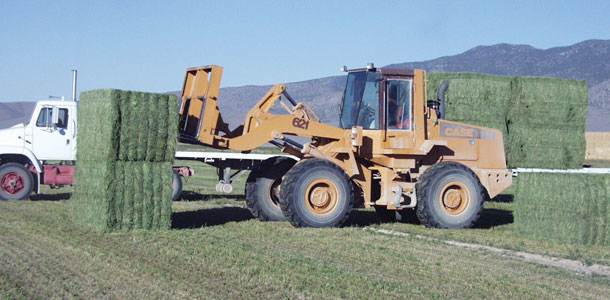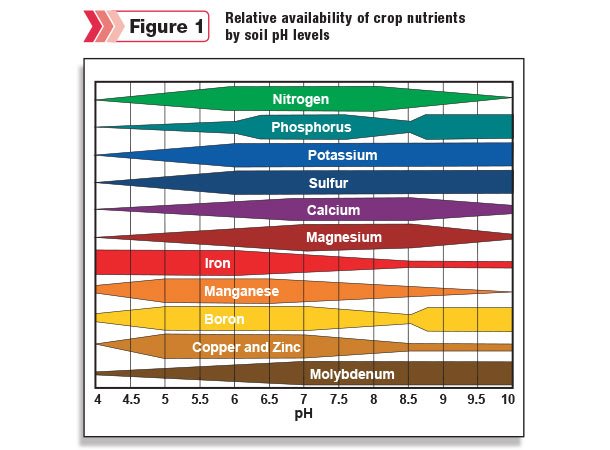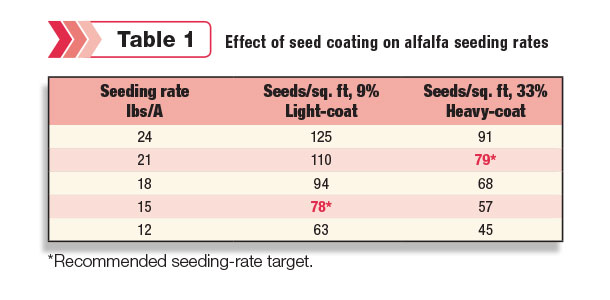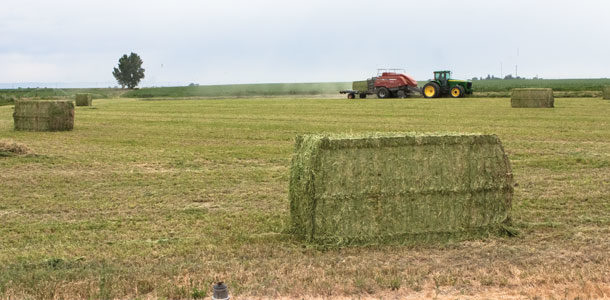Harvesting 10 tons of alfalfa per acre each year is a lofty goal. Whether you aim for this target or you aspire to achieve your farm’s highest yields, doing so begins by successfully establishing a robust alfalfa stand of top-end genetics in high-fertility fields.
Stand establishment starts with genetics
Genetics have become one of the foundational elements for achieving 10-ton alfalfa yields. Three key tips will help you find and plant top-shelf genetics.
First, look for a seed company that invests broadly in alfalfa research and provides the best genetics for your farm. Your seed company representative should be part of your forage operation team.
Second, plant alfalfa with built-in insect and disease resistance, plus winter hardiness. Premium alfalfa varieties can be planted on wet soils where root rot previously threatened alfalfa stands.
The right alfalfa varieties can thrive in high-risk weather and soil situations, giving forage growers greatly improved stand establishment and longevity.
Alfalfa varieties also can balance fall dormancy and fall forage growth while proving to be winter hardy. In northern climates, winter hardiness is best defined as protection of the alfalfa crown against extreme cold exposure.
Previously, winter hardiness was closely related to low fall-dormancy scores. Today, varieties with a fall dormancy (FD) score of 4 and 5 have very high levels of winter hardiness.
One advantage of FD 4 and 5 plants is their ability to produce extra forage growth, especially in the fall growing period.
Third, plant alfalfa that offers supporting yield trial data. University trials and seed companies’ data help prove yield potential of alfalfa varieties. Small differences in yield can drive big differences in your bottom line.
University of Wisconsin trials have shown that top-yielding alfalfa varieties average 0.55 tons per acre per year more than below-average genetics.

With hay prices steadily garnering around $0.10 per pound over the past three years, this equates to approximately $121 per acre per year, or a whopping $1,250 per unit of alfalfa purchased. (This calculation assumes planting 16 pounds of seed per acre and keeping the stand for three years of production.)
Early planting maximizes seeding year yield
Alfalfa germinates at much lower soil temperatures than corn or soybeans – 35°F versus 45°F for corn and 55°F for soybeans. That’s why alfalfa can be planted early in the spring.
However, planting earlier does not eliminate the need to ensure the ground is fit from a moisture standpoint and a seedbed-preparation perspective.
Generally, we expect spring alfalfa seeding to occur between April 1 and May 15. This timing provides seeds and seedlings with the least exposure to moisture stress and potential for crusting problems.
For summer-seeded alfalfa, the goal is to have the crop in the ground by Aug. 15 at the absolute latest. Alfalfa seedlings need a minimum of six weeks growth prior to a killing frost (-5°C) (23°F) to grow large enough and to develop enough root reserves to survive the winter and thrive the following spring.
Prepare, prepare, prepare
The first step to field preparation is to determine fertility needs based on soil tests. Preferably, this is done the year prior to stand establishment, so you have an opportunity to add lime to adjust the soil pH if it is lower than 6.5.
Soil pH is important to maximize nodule development and nutrient uptake. As you can see from the nutrient availability chart (Figure 1), a pH between 6.5 and 7.0 is ideal for alfalfa.
Alfalfa is a large consumer of nitrogen (N) and potassium (K). Nitrogen is supplied through N-producing nodules, which develop on the root.
Research shows no benefit to adding additional N to alfalfa fields with good nodule activity. Potassium must be supplied through supplemental fertilization or manure sources.
Multiple fertilizer applications per year help provide a constant supply of K to alfalfa through the growing season. Potassium is also important for enhancing winter hardiness and survival.
Alfalfa seedbed preparation should focus on achieving a firm seeding environment with few soil chunks or clods. This maximizes seed-to-soil contact and helps maintain a consistent seeding depth for quick and uniform germination.
In clay and loam soils, a planting depth between a quarter-inch and a half-inch is perfect. On sandy soils, planting depths of a half to 1 inch are recommended.
To determine if your seedbed is too hard, too soft or just right to plant, examine your footprint depression after working the field. If your boot sinks about half an inch, or just the sole goes into the ground, conditions are right for planting. If the soil is too soft, seed-depth control becomes difficult and some seed will be planted too deep.
Seeding rate helps ensure yield potential
There is a relatively wide range of recommended alfalfa seeding rates, from as low as 8 to 10 pounds per acre to as high as 18 to 20 pounds per acre. In general, aim for the high end of seeding rate recommendations.
The final stand you establish will help drive yield potential both for the current seeding year and for subsequent years.
Most universities recommend seeding rates of 12 to 18 pounds of pure live seed (PLS) per acre to achieve 80 to 90 seeds per square foot.
While this seems high, plant attrition results in 45 to 50 viable seedlings a month after emergence, and those will be thinned to 30 to 35 plants by the end of the seeding year. If any major weather event or poor soil conditions exist during the establishment phase, plant loss can be higher and result in thinner stands.
Alfalfa is sold with a variety of seed coatings, fungicides and live rhizobium inoculants. Learn to read your alfalfa seed tag to determine PLS per pound.
Then make proper seeding rate adjustments on your equipment to avoid overseeding or underseeding. Seed coating amounts can be as high as 35 percent or as low as 8 percent.

Seed germination rates also vary significantly among varieties. Obviously, the cost of seeding an acre of alfalfa differs dramatically based on seed coating and germination rates (Table 1).
Control competition
Alfalfa plants are often met with competitors: nurse crops or weeds. While seeding alfalfa with a nurse crop or interseeding alfalfa with a grass species offers some benefits, these plants also compete aggressively with alfalfa in the early stages of seedling establishment.
Your decision to grow a nurse crop depends on your forage needs and your goals for alfalfa in the first year of seeding. Ontario researchers have found nurse crops to be extremely competitive, reducing yields of alfalfa throughout the life of the stand.
Weeds are also great competitors during the establishment phase. To manage weeds in pure alfalfa stands, several herbicide options are available and should be used to keep weeds at bay.
Finally, be on the lookout for potato leafhoppers, especially during the first two to three months of growth. These sucking, piercing insects can severely stunt growth of young alfalfa plants, leading to reduced yields and increased susceptibility to other stress factors.
Ten-ton alfalfa yields? Start your engines
Ten-ton yields are achieved by paying attention to the starting line. Following the above recommendations will have you well on your way to growing a highly productive alfalfa crop that delivers the high forage and protein yields needed by your operation. In addition, if management and fertility are looked after over the life of the stand, you should be rotating a great, productive stand of alfalfa into corn and capturing the nitrogen and soil health benefits it can provide. FG

Daniel Wiersma
Livestock Information Manager
DuPont Pioneer











